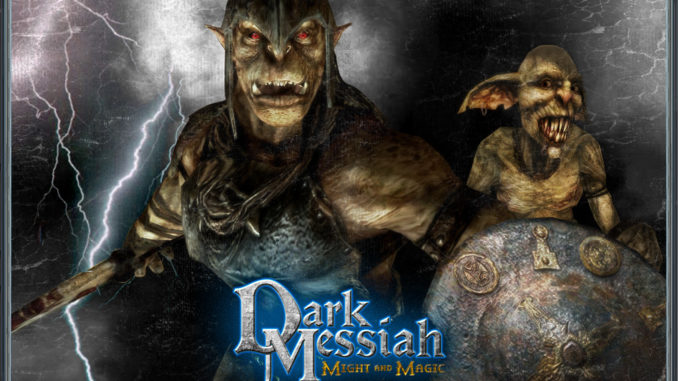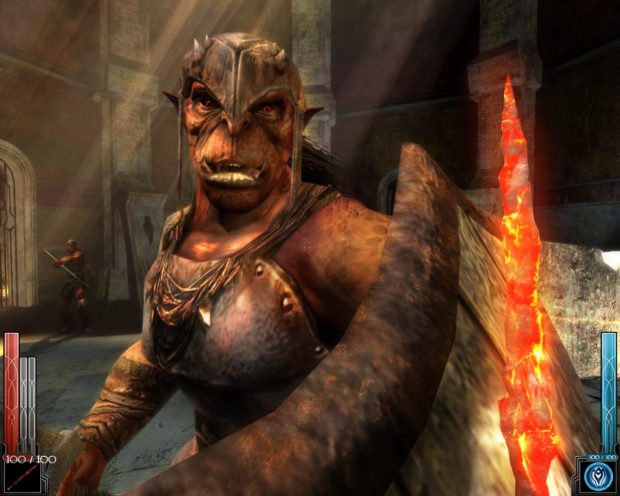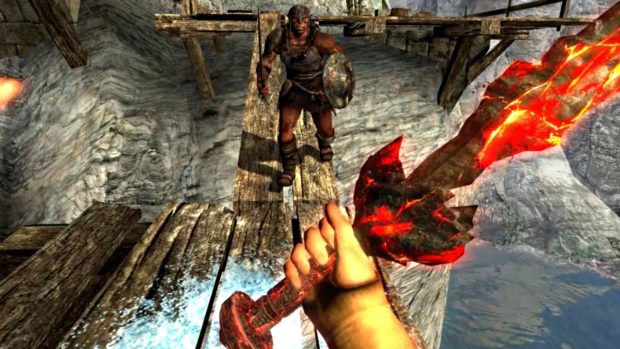
 Next year marks the tenth anniversary of Might and Magic’s Role Playing debut on the Xbox 360 console. Primarily aimed at PC gamers, the Might and Magic franchise as a whole, has seen very little success in the home console market. Partially to blame for the series’ shortcomings is the rise of the Elder Scrolls franchise in modern gaming culture. Everyone within the gaming community has had at least some exposure to Skyrim in one form or another, leaving the Might and Magic series in the back burner of the fantasy genre. But Elder Scrolls’ dominance is irrelevant when one considers the depth of gameplay that Dark Messiah had to offer players back in 2008. Undoubtedly a diamond in the rough, Dark Messiah is truly in need of a revisit, even with the monolithic dominance that Elder Scrolls has had in the visual arts landscape.
Next year marks the tenth anniversary of Might and Magic’s Role Playing debut on the Xbox 360 console. Primarily aimed at PC gamers, the Might and Magic franchise as a whole, has seen very little success in the home console market. Partially to blame for the series’ shortcomings is the rise of the Elder Scrolls franchise in modern gaming culture. Everyone within the gaming community has had at least some exposure to Skyrim in one form or another, leaving the Might and Magic series in the back burner of the fantasy genre. But Elder Scrolls’ dominance is irrelevant when one considers the depth of gameplay that Dark Messiah had to offer players back in 2008. Undoubtedly a diamond in the rough, Dark Messiah is truly in need of a revisit, even with the monolithic dominance that Elder Scrolls has had in the visual arts landscape.
The Story
Set in the fictional fantasy world of Ashan, Dark Messiah follows the story of a young mage in training named Sareth, who is under the tutelage of the wise wizard Phenrig. As the plot unfolds, the player learns of the history of the land of Ashan. Through exposition, players are told of the Great War of fire that led to the unification of Humans, dwarves, and elves, nearly a thousand years before the start of the game’s opening sequence. Ashan’s greatest champions of each race united to fight off hordes of the undead as the Skull King’s minions sought to conquer the land and plunge it into an age of darkness. These champion races of Ashan fought off the army of the undead, leaving their perspective kingdoms in ruin. But since this great unification began to unravel, man and its fellow beings lost their truce and the different races of Ashan began to scatter across the barren world.
Sareth is born onto this broken reality, and the Great War of Fire is nothing but a mere memory in the fragmented upon which he inhabits. As the narrative unfolds, the protagonist undergoes an expedition to retrieve an ancient artifact called the Shantiri crystal. After disposing of the crystal, Ashan is tasked with venturing to the city of Stonehelm where he is to meet with an old ally of Sareth named Menelag. It is in Stonehelm where the plot truly unfolds after the city is attacked by demons under the control of the malevolent necromancers. Ashan is charged with the defense of the city as he takes control of Stonewalls’ ballistic military operations. Menelag joins the fray to aid the young Ashan in the defense of Stonewall. After fighting back the army of the undead, a feast is held in Ashan’s honor, upon which the protagonist and Menelag decide to set sail the following morning in search of the ancient demon known as The Skull. At this point, inciting incident of the journey across the sea unfolds into a Tolkien-esque plot that spans several landscapes and hundreds of hours of gameplay that include both the main quest and side plots. The world of Ashan is inhabited by an array of varying races each with their own history and culture giving players enough sociological and histrionic depth that runs parallel to the massive world of Morrowind and Skyrim.
The Multiplayer
 Dark Messiah features a player vs player online multiplayer setting which allows different factions to compete for points against each other. This multiplayer setting has only two races: humans and the undead, with each group containing five different character class sets to choose from. Although not as expansive as it should be, the online multiplayer is a nice addition to an already expansive world to explore. Unfortunately, at times the multiplayer’s limitations come to the forefront as the absence of elves and dwarfs provide players with an underwhelming experience. The Coliseum battle mode provides a nice touch as champion classes can battle it out in front of an audience for character development points. Unfortunately, the experience points achieved through multiplayer online doesn’t carry over to the single-player campaign mode, which is disappointing when you consider a number of hours a player invests into the online battle mode.
Dark Messiah features a player vs player online multiplayer setting which allows different factions to compete for points against each other. This multiplayer setting has only two races: humans and the undead, with each group containing five different character class sets to choose from. Although not as expansive as it should be, the online multiplayer is a nice addition to an already expansive world to explore. Unfortunately, at times the multiplayer’s limitations come to the forefront as the absence of elves and dwarfs provide players with an underwhelming experience. The Coliseum battle mode provides a nice touch as champion classes can battle it out in front of an audience for character development points. Unfortunately, the experience points achieved through multiplayer online doesn’t carry over to the single-player campaign mode, which is disappointing when you consider a number of hours a player invests into the online battle mode.
The Skill Tree System
As Ashen progresses throughout the campaign, players can upgrade the protagonist with an assortment of skill sets that sway the main character towards either a melee or magic style of a warrior. For those who appreciate the middle of the road kind of skill set, Ashen can deploy magic skill sets along with light melee combat abilities resembling that character set of a Paladin warrior. Through the implementation of a character tree skill system, Ashen can develop into three specific areas of development: warrior, mage, and miscellaneous. Warrior and mage are pretty self-explanatory, while the miscellaneous category contains a variety of sub-traits such as stealth, healing magic, and vitality. Not as intricate as Skyrim, but not a minute as the first entry in the Diablo series, Dark Messiah of Might and Magic contains a sufficient character class development system that should satisfy even the most advanced RPG player.
The Gameplay
Dark Messiah of Might and Magic tells its story from a first-person point of view, with the main character interacting with his environment from predominantly his perspective. The world of Ashan is divided into different city-states ranging from mountaintop villages to snow-filled fields of frost giants. Each region of the world map feels like one giant medieval fantasy trope that at times feels like a rip off of Dungeons and Dragons themes rather than an homage. Slight dips in frame rate along with mundane dialogue and character interactions can slow the progression of the game’s story line. But this is made up for by beautiful visuals and a depth of subplots that takes the player on an odyssey rather than a mere diversion of plot points.
The world of Ashan is dense, and to make it easy, the game’s developers have implemented a beast mount system where players can traverse the landscape on horseback to speed up the travel between quests. An important development in gaming when one considers how many role-playing titles, like Dragon’s Dogma, failed to contemplate the necessities of having a fast travel system when seeking to create an open-world adventure. Dark Messiah’s travel system was sufficient, if not perfect, in that one gets a sense of the setting’s overall vastness when looking at the landscape from Sareth’s point of view as he traverses the open plains on horseback. Instead of merely teleporting from the side of the map to the other, all travel is done in real time. With a day and night cycle that gives players a sense of time’s passing, Dark Messiah is truly mesmerizing with its interactive backdrops and true to life weather system.
The Verdict
As the game approaches a decade since its initial release on the Xbox 360, the Might and Magic series as a whole has seen a less than stellar release on the home console market. Might and Magic Heroes was a fun Player vs Player experience that felt more like an Indy app rather than a mainstay in the franchise. In the modern era of high definition remakes and remastering, Dark Messiah is definitely more than ready for another romp on current gen consoles. With the switch releasing Skyrim for this December, Nintendo would be wise to give RPG fans another trip down the dark caverns and open seas of Ashen. Dark Messiah was a decent entry in the Might and Magic series, but it had flaws, especially with load times and character animations. But this does not detract from the game’s overall quality. Minute touches and an HD upgrade would be enough to resurrect this long-forgotten masterpiece.
Although it is not as nearly open world as Skyrim, Dark Messiah offered players a chance to indulge in escapist fantasy while still being held down to reality by solid plot structure. Might and Magic is a series that is the counterpoint to Morrowind’s monopoly. Dark Messiah epitomizes everything that could have been if it had more time in development. Might and Magic is a series that has a devoted fan base for sure, but now is the time to loosen the grip that Bethesda has had on the video game market. Skyrim is a masterpiece no doubt about its credentials, but Dark Messiah deserves its own place in the pantheon of great open world RPGs.


Leave a Reply